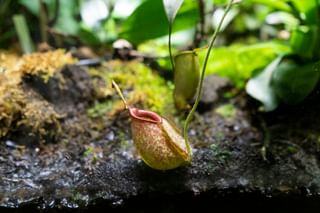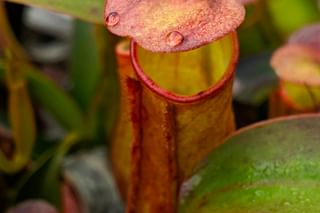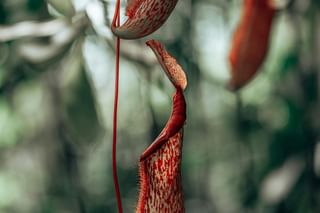How to take care of a Nepenthes (Monkey Cup) plant
Learn how to care for Nepenthes, also known as tropical pitcher plants. Discover tips on humidity, fertilization, and propagation to keep your carnivorous plants thriving. Sign up for our newsletter for more plant care advice!
Normal houseplants are great, but what do you think about carnivorous plants?! In the post about taking care of a Venus flytrap I mentioned that I've always been fascinated with carnivorous plants, because they're plants, but kind of act like animals.
If you're also fascinated with carnivorous plants, you'll want to get your hands on this almost alien-looking plant. Nepenthes, with its odd pitcher-shaped leaves, are native to the jungles of Southeast Asia. Which means you'll have to give it plenty of humidity at all times. Why do I mention this now? Because this makes it a bit of a tricky plant, and it's probably not the best choice for a beginner.
Still want to know how to take care of it? These are the topics we're going to look at:
Let's start with watering this incredibly houseplant!
Watering a Nepenthes
In the introduction, I mentioned Nepenthes is native to Southeast Asia, which means it likes moisture, heat, and bright light. So, how do you water a plant like that? The most important thing to get right is to keep the soil lightly moist at all times. Nepenthes should not dry out, but should also not grow in wet soil.
To help you water this plant correctly, I've got two essential tips: Get a pot with drainage holes to drain the excess water, and get soil that holds onto moisture for a few days.
Pot with drainage holes
By using a pot with drainage holes, you make sure any excess moisture drains from the pot. This helps to prevent the plant from standing in wet soil and developing root rot.
A convenient way to water your plant is by bottom-watering it. This helps the soil soak up the water it needs and keeps the plant itself dry, which helps to prevent fungus.
Soil mix for Nepenthes
Besides drainage holes, you'll need soil that holds onto moisture for a few days. Since the soil shouldn't dry out (too quickly), you'll need to add a few things to keep the soil light and airy. I recommend a mixture of 1/2 potting soil, 1/4 perlite, and 1/4 peat moss.
This soil mixture will keep the soil from compacting over time, holds onto moisture for a while, but also drains excess moisture to the bottom of the pot quite quickly. Because the soil stays airy, oxygen can freely flow to Nepenthes' roots, which also helps to prevent root rot.
Most types of Nepenthes like growing in slightly acidic soil, so you can help achieve that growing environment by adding peat moss to the soil.
Sunlight for Nepenthes
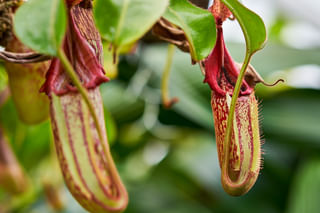
When it comes to sunlight, Nepenthes is actually quite easy. It likes full sun all day. Some varieties of Nepenthes, which you might also refer to as the highland species, love hot and sunny days and cooler night. While other varieties, which usually grow in the lowlands, like heat all day and all night.
So if you've got a bright, sunny spot in your house, reserve this spot for your next carnivorous plant!
Fertilizing a Nepenthes
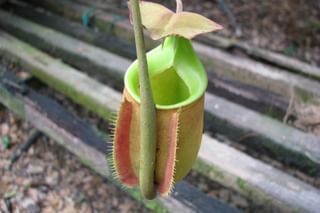
As you might have expected, you won't really have to fertilize your Nepenthes. In its native growing environment, it often grows in nutrient-poor, but highly organic soil. It knows how to survive. If you want to help your plant a little, you can feed it insects like crickets or wasps.
If you'd prefer to use a normal fertilizer, instead of feeding it insects, you can use diluted orchid fertilizer as well. Orchids grow in similar conditions, so their fertilizer will work for Nepenthes as well.
Humidity levels for Nepenthes
As we've already discovered earlier, high humidity is very important for this plant. If the humidity levels are too low, the traps might turn brown or not form at all.
You can raise the humidity by growing them in a large, clear, vented plastic bag while new pitchers form, then remove the bag once traps are mature. A misting system helps maintain humidity, and good ventilation is also essential.
Good ventilation will help prevent mold in this humid environment.
Propagating Nepenthes for free plants
We all love free plants, so I'm sure you want to know how you can propagate your Nepenthes to get some free plants out of it!
The easiest way to propagate Nepenthes is to take cuttings and let it root in water. After a few weeks, you should see some roots appear, after which you can carefully plant it in the soil mixture we looked at earlier.
Conclusion
Caring for Nepenthes isn't the easiest thing to do, but once you get the hang of it, you'll have one of the most fascinating houseplants you can imagine (my opinion, of course).
The most important thing to keep this plant healthy is to keep the humidity levels high, give it warm temperatures and plenty of sunlight. Oh, and if you want free plants, don't hesitate to give propagating your Nepenthes a try!
If you enjoyed these tips and want more plant care advice, be sure to sign up for my newsletter for more plant care tips every week!
Thank you for reading this post! I hope it helps you to keep your plants healthy and beautiful! If you're looking for more guides on specific plants, you can always request a plant guide to get a guide for the plant you have trouble with.
Test your plant care knowledge
Quiz completed!
Want to learn more? Sign up for my newsletter to receive free tips in your inbox!
Sign up now!